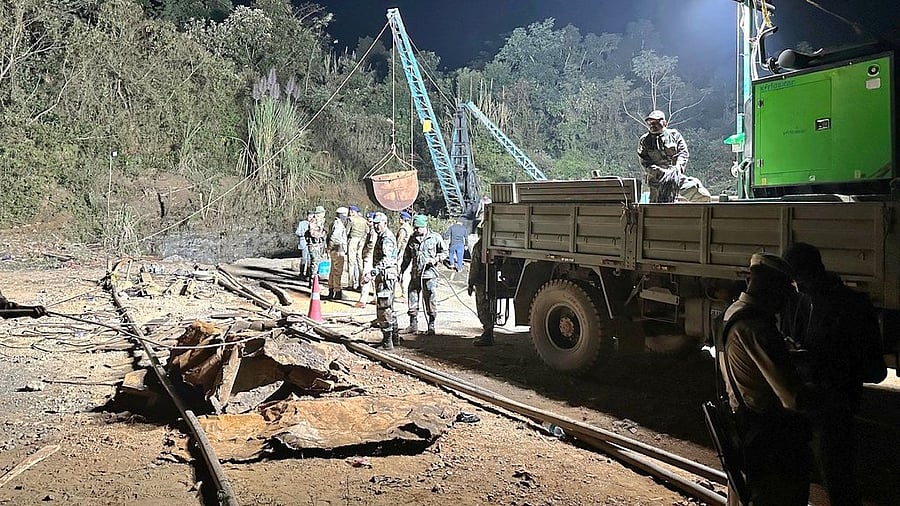
Army Rescue operations
Courtesy Indian Army
Guwahati: The disappearance of at least nine workers in a flooded coal mine in the hilly Dima Hasao district in Assam on Monday brought to light that illegal "rat hole" coal mining continues on the hills of the Northeast despite several fatal mishaps in the past and a ban on the illegal practice by the Supreme Court and the National Green Tribunal (NGT) in neighbouring Meghalaya.
The latest mishap on Monday at Tinkilo, an interior place under Umrangso police station, followed almost similar pattern--a case was registered, one person, identified as Punish Nunisa, was immediately arrested and the state government admitted that the mining was being done illegally. "Prima facie it seems to be an illegal mine," CM Himanta Biswa Sarma admitted on Tuesday as the army, Navy and NDRF personnel continued rescue efforts.
Officials of Dima Hasao Autonomous Council, which administers Dima Hasao district, tried to shrug off the responsibility saying they were unaware of the illegal act. BJP is in power both in the state and the council.
As the state government remained busy in the rescue efforts, Opposition parties demanded a judicial inquiry claiming that those in power and officials in the district administration were aware of the illegal coal mining. "Rampant and unabated rate hole coal illegal mining is going on in Dima Hasao, Tinsukia and Karbi Anglong district. The coal is extracted without following the safety and environment norms and transported illegally to the rest of the country. Can such practice continue without knowledge of the administration and the government?" Lurinjyoti Gogoi, president of Asom Jatiya Parishad (AJP), an opposition party in Assam, asked on Wednesday.
"Such illegal mining is going on despite a ban by the Supreme Court and the NGT in Meghalaya. The poor workers, who work in such illegal mines for money, die during such mishaps," he said.
At least 21 people died in three major mishaps in "rat hole" coal mines in Meghalaya's Jaintia Hills in 2018 and 2021 and in Wokha district of neighbouring Nagaland in 2024.
Rat hole mining
The wells are first dug vertically inside jungles and workers then make horizontal shafts in order to extract coal. Some shafts are so narrow that workers have to crawl like rats and so these are called rat hole mines. Workers, who managed to come out of the flooded well at Umrangso on Monday, told journalists that the well was 300 feet deep and there are numerous horizontal shafts.
"The workers are taken inside the well on iron boxes with the help of carnes. We carry carts and iron tools to extract coal. The coal cutters use battery operated lights mounted on their heads and also use walkie talkies for communication inside," one of the workers said on Wednesday.
"The well got flooded in minutes after workers probably dug a shaft and hit a nearby well, which was probably already flooded," he said. He said the workers get Rs. 2,000 to Rs. 2,500 per day in a coal mine against daily wage of Rs. 400 for other works. "We do it for livelihoods," he said.
An anti-mining activist in Meghalaya, Agnes Kharsiang on Wednesday told DH that rampant coal mining is going on in the state's West Khasi Hills, South West Khasi Hills, East Jaintia Hills and South Garo Hills. "It's rampant in Meghalaya even today. The workers are brought from Assam, Bengal and even Nepal and Bangladesh. There is a network with police, politicians and coal mafias," she said.
The Opposition Congress in Assam also alleged nexus of politicians and those running the Dima Hasao Council in the illegal coal mining.
Illegal coal mining was banned in Meghalaya by the NGT in 2014 and the Supreme Court later. The issue hogged headlines in December 2018 when at least 15 workers were buried in an illegal coal mine at Ksan in Jaintia Hills district. Bodies of some of the victims could not be retrieved despite efforts by several agencies including the Army and the Navy deep divers. Meghalaya government, however, moved a petition in the Supreme Court in 2019 following which the apex court asked the Centre and the state government to formulate a policy to ensure safety and prevent adverse impact on the environment. Meghalaya government later provided permission to some miners as per a new mining policy.